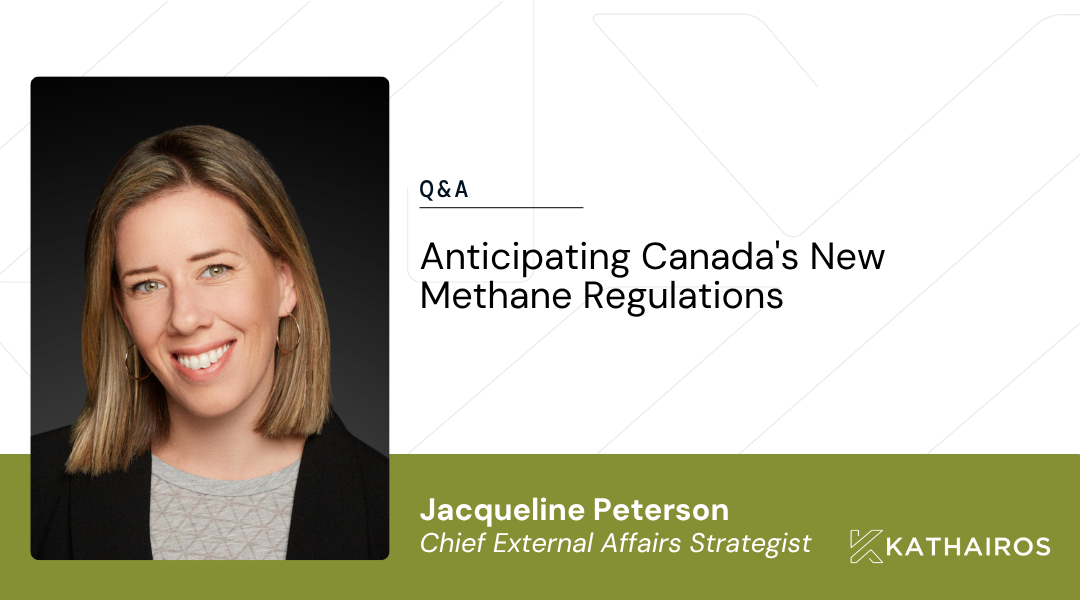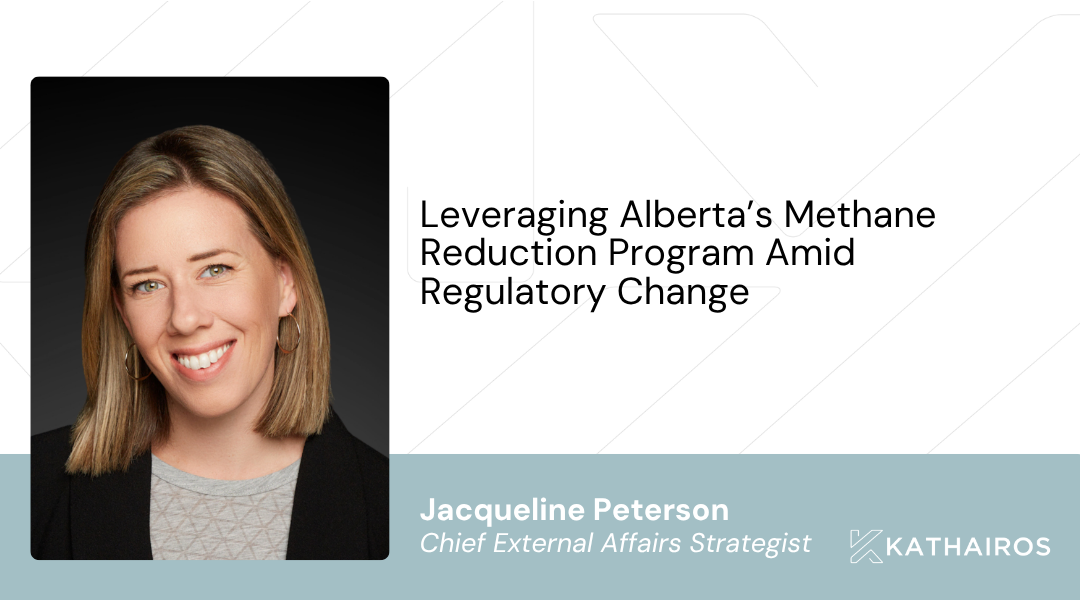
Kathairos has emerged as the leading North American solution for methane elimination from pneumatics, with more than 2,400 systems in operation across North America and over 70 major oil and gas producer partners.
In this post
We sat down with Jacqueline Peterson, Kathairos' Chief External Affairs Strategist, to discuss Canada’s upcoming enhanced methane regulations — what they could include, how they’ll impact producers, and what companies can do now to prepare.
What do you anticipate will be included in the new methane regulations?
The enhanced methane regulations involve amendments to the Regulations Respecting Reduction in the Release of Methane and Certain Volatile Organic Compounds (Upstream Oil and Gas Sector) passed in April 2018. The enhanced regulations, which are expected to be finalized by the end of 2025, are designed to reduce methane emissions from oil and gas operations 75% by 2030 (based off a 2012 baseline). This will require more stringent equipment standards to address routine venting and rigorous monitoring requirements designed to minimize the size and occurrence of fugitive leaks.
Some key requirements outlined in the 2023 draft legislation include:
- Prohibition of the intentional venting of hydrocarbon gas into the atmosphere, with few exceptions aside from safety and equipment maintenance. This applies, for instance, to pneumatic devices, separators, dehydrators, and compressors.
- Increased measures to manage emissions during the combustion of hydrocarbon gas. Combustion systems must operate at 98% efficiency; flaring limited.
- Quarterly or annual inspection schedules to minimize fugitive emissions.
The draft regulations were published in the Canada Gazette I on December 16, 2023. Since then, the government has collected feedback and public commentary which it is integrating into the revised rules. Once final, the enhanced methane regulations will be published in Canada Gazette II.
The proposed requirements apply to upstream, midstream, and transmission facilities. We will be keeping an eye out to see how and whether the final set of regulations, upon publication in CG-2, differ from those originally proposed in CG-1.
As was the case with the 2018 methane regulations, it is expected that the provinces will work with the federal government to establish “equivalency agreements” that allow the provinces to create, implement and enforce their own set of regulations, so long as they meet the standards set by the federal government.
While this may involve slight adjustments or changes, any updated provincial methane regulations are unlikely to be notably different than the requirements set by the federal government, as the term equivalency suggests.
What will these regulations mean for Canadian oil and gas producers?
The enhanced methane regulations will require producers to significantly reduce methane emissions across their facilities. This will involve making investments in non-emitting equipment and increasing leak monitoring efforts.
Any existing facilities with increased production in 2027 or 2028 (such as pads with new wells added) will need to eliminate venting across the entire facility by January 1, 2028, or 2029, respectively. Sites with increased production in 2028 are subject to the new requirements come 2029. The intent is to create staggered compliance deadlines and ensure a gradual pace of conversions over the next 4 years. Currently, producers are only required to ensure that any new devices installed are non-emitting, not that any other devices at the site also need to be retrofitted at the same time.
Under the proposed regulations, operators will also be required to monitor for leaks more frequently. “Type 1 facilities” – those with a natural gas driven compressor, flare, storage tank or gas-liquid separator – will need to conduct quarterly inspections, as well as an annual inspection. “Type 2 facilities” (those without any of the above equipment) will need to perform annual inspections.
How can producers start preparing now?
Forward-thinking oil and gas companies can begin trialing different methane solutions prior to the enhanced methane regulations taking effect. This will ensure that producers are aware of the options available and which systems work best under different scenarios. Trialing different solutions allows field operators to gain experience with different solutions and get a hand for how the technology works in field conditions. (Kathairos is told repeatedly that solutions that look good ‘on paper’ don’t always stand up in real-world environments - think -40c in Grande Prairie in January). Identifying preferred solutions early on can facilitate long-term planning and allow producers to lock in supply at low prices for extended contracts.
What is the anticipated timeline for rollout and compliance?
According to the draft regulations, affected facilities will need to begin monitoring sites for fugitive emissions beginning in 2027. Sites with increased production in 2027 or 2028 will need to eliminate venting by the following calendar year (January 1, 2028, or January 1, 2029, respectively). All remaining facilities meet the new emissions requirements by 2030. While that might seem far away, producers that make plans and act early will benefit from securing supply chains and allowing themselves sufficient time to complete the work.
The speed and pace by which companies will need to act will be determined by how many facilities they operate and how soon they start. For example, a company with 500 facilities would be looking at converting around 125 sites per year to be compliant by 2030, if they started in 2026. If the company waits until 2028, this annual number doubles.
Companies of all sizes may face constraints if they wait to do all their retrofits in the final year. While Kathairos can dispatch hundreds of units every month, companies may encounter delays due to limited availability of instrumentation techs or other service providers required for equipment installation.
Finally, companies that act sooner may benefit from increased carbon offsets, given they will be able to generate offsets over a longer activity period than facilities that commence closer to the compliance date (at which point offsets will no longer be able to be generated).
How do you expect industry to respond — with concern, innovation, or both?
To be sure, the oil and gas industry is not lobbying fervently for the enhanced methane regulations. The regulations will come at a cost for the industry amid competing priorities; the regulations will require, in effect, a mass ‘clean up’ of existing facilities. Typically, funds and attention are paid to new facilities, drilling projects and production; less time and money is usually directed to existing production sites.
However, most people in the oil and gas industry view reducing methane emissions as emblematic of operational performance and environmental stewardship. Moreover, commercially-available technologies exist today that are affordable and reliable, making the transition to zero-methane a lot easier than decarbonizing other parts of the industry.
Ultimately, the oil and gas industry is looking for certainty from regulators about what is expected of them so they can move forward confidently. The energy sector leads the world when it comes to project management and engineering. Reducing methane emissions from production facilities is a challenge oil and gas operators are well equipped to do.
How could these regulations position Canada on the global stage in emissions reduction?
Countries across the world have signed on to the Global Methane Pledge and have committed to reduce methane emissions 30% by 2030. Many of the countries have introduced measures or regulations aimed at reducing the methane intensity of the fuel produced or imported in their jurisdictions in order to reach these targets. For example, the EU Methane Regulations include methane monitoring, reporting, and reduction requirements on all imported gas. A consortia of major power producers in Japan and South Korea has also created a methane intensity framework for all imported fuels through its CLEAN initiative. These timelines are similar to those proposed in the draft Canadian regulations – monitoring requirements come 2027, methane intensity requirements come 2030.
Canada’s enhanced methane regulations, once finalized, will position Canada’s oil and gas industry well to meet the requirements set out in Europe and East Asia. Ultimately, continuing to act on methane will ensure Canada remains competitive within evolving global dynamics and a broader societal shift towards balancing energy security with emissions concerns.

.png)
